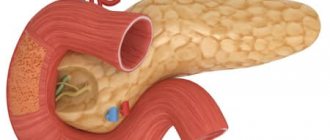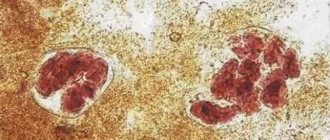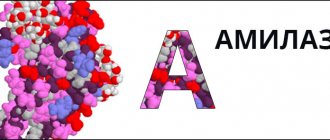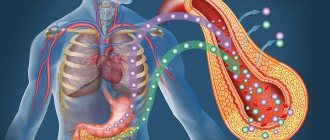What is pancreatic elastase
Pancreatic elastase is a digestive proteolytic enzyme that is produced in the pancreas. Its function is the enzymatic breakdown of elastin and other proteins. In addition to hydrolase, fifteen more enzymes are produced in this place. The key ones are amylase, lipase, collagenase, trypsin, chymotrypsin. But elastase is produced exclusively in the pancreas and is not found in any other organ. Bypassing the intestines, the hydrolase enters the feces without being destroyed by other digestive kinases.
Another feature is that its production does not change when taking medicinal or enzymatic preparations. Little depends on the nature of the diet, age and gender of the patient. A similar property of the marker, when examining feces, is used as a highly sensitive and specific external test of the exocrine activity of the pancreas. The established norm for the actual content of pancreatic elastase in feces is from two hundred to five hundred micrograms per gram of substrate.
Elastase
Elastase pancreatic
(eng.
Elastase
) - a proteolytic enzyme that breaks down peptides and proteins, endopeptidase.
The second name is pancreatopeptidase
E.
To distinguish it from leukocyte elastase, pancreatic elastase is sometimes called elastase 1
. Molecular weight 28,000 daltons. Elastase is synthesized in the pancreas in the form of an inactive form - the proenzyme proelastase, which, as part of pancreatic juice, enters the duodenum, where, under the influence of trypsin, it is converted into elastase.
Elastase, trypsin and chymotrypsin represent a group of serine proteases due to the presence of serine in their active site. They belong to the same family and make up 44% of the total protein of the exocrine pancreas. Elastase has a broader specificity of action than trypsin. Elastase is most active in the cleavage of peptide bonds formed by amino acids with small hydrophobic radicals - glycine, valine, leucine, isoleucine and serine. Elastase is capable of breaking down the protein elastin, which is not hydrolyzed by either trypsin or chymotrypsin.
Elastase can enter the blood in increased quantities during pancreatitis.
Elastase 1 and chymotrypsin remain relatively stable when passing through the gastrointestinal tract. Their determination is easy to perform and relatively inexpensive, but these tests are characterized by low sensitivity for mild and moderate exocrine pancreatic insufficiency and low specificity for certain pathologies of the gastrointestinal tract not related to the pancreas (Maev I.V. et al.).
Stool test for elastase
Elastase is not destroyed when in the intestine, so testing the elastase content in feces is an important indicator of exocrine pancreatic function.
Elastase of animal origin supplied with food does not affect the analysis result. In newborns, the elastase content is low and reaches adult levels by two weeks of age.
A stool test for elastase is mandatory if there is a suspicion of cystic fibrosis. In addition, indications for the study are:
- chronic and acute pancreatitis
- cholelithiasis
- diabetes mellitus types I and II
- lactose intolerance
- pancreas cancer
- pancreatic injury
- Crohn's disease
- obstructive jaundice
- abdominal pain or indigestion of unknown origin
Interpretation of analysis results:
- more than 200 mcg of elastase per 1 g of feces is normal
- from 100 to 200 mcg of elastase per 1 g of feces - mild to moderate severity of exocrine pancreatic insufficiency
- less than 100 mcg of elastase per 1 g of feces - severe form of exocrine pancreatic insufficiency
The elastase test indicators do not depend on age, gender, previous treatment with enzyme preparations and proteolysis inhibitors. Affect the results of the analysis: castor and mineral oils, bismuth, magnesium or antidiarrheal drugs, irrigoscopy.
Publications for healthcare professionals addressing the role of elastase in gastroenterology
- Sablin O.A., Grinevich V.B., Uspensky Yu.P., Ratnikov V.A. Methods for studying exocrine function // In the book. Functional diagnostics in gastroenterology. St. Petersburg, 2002.
- Golubev N.N. Disorders of cavity digestion in patients with peptic ulcer and their correction with the help of polymer preparations. Abstract of dissertation. PhD, 14.00.05 - internal diseases. MGMSU, Moscow, 2008.
- Mokrousova N.V. Connective tissue metabolites in assessing the course and prognosis of gastroesophageal reflux disease. Abstract of dissertation. PhD, 14.00.05 - internal diseases. Saratov, 2002.
- Maev I.V., Kucheryavyi Yu.A., Andreev D.N., Dicheva D.T., Gurtovenko I.Yu., Baeva T.A. Chronic pancreatitis: new approaches to diagnosis and therapy / Educational manual for doctors. M.: FKUZ "GKG Ministry of Internal Affairs of Russia". 2014. 32 p.
- Maev I.V., Samsonov A.A. Chronic duodenitis (Algorithm for diagnosis and treatment tactics) / Manual for general practitioners, therapists, gastroenterologists: Textbook. - M: GOU VUNMTs MH and SR RF, 2007. 80 p.
On the website GastroScan.ru in the “Literature” section there is a subsection “Secretion, digestion in the gastrointestinal tract”, containing articles for healthcare professionals on this topic. Back to section
There are two types (fractions) of elastase:
- Pancreatic elastase is produced in the exocrine part of the gland. Once in the duodenum, hydralase is conjugated with trypsin, becoming active.
- Serum elastase, which is a pancreatic proenzyme, enters the blood during the destruction of pancreatic cells. In terms of the structure of the molecule, the second completely corresponds to the enzyme found in immunological cells and the walls of the aorta.
A diagnostic test based on monitoring the concentration of elastase in feces is widely used to assess the exocrine activity of the pancreas. This method has very high specificity, information content and is completely non-invasive.
Thus, analysis for this enzyme in children with diarrhea syndrome of unknown etiology makes it possible to confirm or exclude cystic fibrosis at an early subclinical stage, preventing the development of life-threatening multiple organ complications.
In what cases is an examination prescribed?
Many functional disorders of the gastrointestinal tract potentially have similar manifestations. Most often, discomfort appears after a heavy meal, signs of fermentation in the form of bloating, and stool disturbances. Even the structure and consistency of feces is transformed. Based on such symptoms, one can only make an assumption about the nature of the clearly pathological process.
Analysis of the coprogram will potentially detect the presence of undigested food debris, the presence of protein, undigested lumps of fat - which happens with atrophic gastritis, inflammatory bowel diseases, and accelerated passage of feces. But real symptoms are also observed when the enzymatic activity of the pancreas is disrupted. Determination of fecal elastase levels can usually confirm or refute the initial diagnosis.
Fecal analysis for such a marker is the most indicative preclinical method for differential diagnosis of the source of dyspeptic symptoms. When the symptoms are erased, it is difficult to determine whether digestive disorders are of inflammatory or enzymatic origin. An ordinary coprogram helps to assess the general enzymatic activity and digestive capacity of the gastrointestinal tract, and the level of marker in feces - secretory pancreatic insufficiency.
Conditions in which changes in the enzyme content in feces are an important diagnostic criterion:
- Genetically determined damage to the exocrine system (cystic fibrosis);
- Inflammatory and destructive processes in the gland;
- Impaired passage of bile with obstruction of the excretory ducts;
- Diabetes;
- Crohn's disease (granulomatous enteritis);
- Oncological processes in the pancreas;
- Cryptogenic abdominal syndrome;
- Cystic fibrosis of the pancreas.
Patient preparation rules
Feces are collected after spontaneous defecation, should not contain foreign impurities and are delivered to the ML “DILA” within 2 hours. Material for research collected after an enema, taking medications that affect peristalsis, taking castor or vaseline oil, after administering suppositories, or drugs that affect the color of stool (iron, bismuth) is not accepted. You should not collect biomaterial during menstruation, in the presence of bleeding hemorrhoids, blood in the urine, or after significant effort during defecation. Studies should not be carried out within 2 weeks after instrumental studies of the gastrointestinal tract or medical procedures that can cause mechanical damage to the mucous membrane (for example, colonoscopy, sigmoidoscopy, bowel cleansing with enemas, etc.). There is no need to discontinue pancreatic enzyme replacement therapy.
You can add this study to your cart on this page
Preparation for the procedure
Pancreatic secretory insufficiency is almost impossible to assess without invasive interventions, but the level of pancreatic elastase in the stool always changes in proportion to the concentration of enzymes in the digestive juice.
The enzyme itself is produced in the pancreas in an inactive form and is activated after contact with trypsin. The ratio of enzyme fractions produced by exocrine pancreatic cells is a constant value. A marker of the level of pancreatic activity is pancreatic elastase contained in feces.
It, being resistant to the action of other digestive enzymes, accumulates in feces and is a remote marker of the condition of the pancreas. Elastase is produced in fixed quantities. The concentration of this marker is five times higher in feces than its concentration in pancreatic secretions. These numbers are not affected by medications or enzymes.
The enzyme concentration in feces is maintained for a long time under appropriate sample storage conditions.
For high reliability of the research result, feces during collection should not be contaminated. The optimal volume of stool for research is 3-5 grams.
It is recommended to collect stool in a special sterile container for stool - a stool collector with a spatula.
Before taking stool for examination, it is strictly forbidden to take laxatives and food that can speed up the evacuation of stool. Studies involving oral administration of contrast agents are excluded, as are any endoscopic procedures performed two days before stool collection. The result will not be representative if the consistency of the stool is changed due to a bowel disorder (constipation, disorder). If you have hemorrhoidal rings that tend to bleed, make sure that there is no blood in the stool sample.
Interpretation of results: norm and deviations
Elastase in feces is determined in mcg per 1 g of feces.
- With a normal level of exocrine activity of the secretory cells of the pancreas, pancreatic elastase in the feces is at the level of 200-500 mcg/g.
- If the level of elastase in the feces is determined in the range of 100-200 mcg/g, they speak of a compensated disorder of enzymatic activity, which requires drug therapy.
- An enzyme content in feces of less than 100 mcg/g requires urgent medical intervention.
- An increase in the marker content over 500 mcg/g allows one to suspect an oncological process or hypersecretion against the background of acute pancreatitis or cholelithiasis.
The reasons for the deviation from the norm with a compensated decrease in function, when the content of pancreatic elastase in the feces drops slightly, lie in the presence of chronic pancreatitis. But often, when the process is sluggish, this method of control turns out to be uninformative.
A decrease in the level of enzyme in feces below 100 mcg/g requires additional examination. The level of the pancreatic fraction in the analysis may fall, but the enzyme is produced by secretory pancreatic cells in a normal volume. The appointment of a stool test is accompanied by monitoring of serum elastase fractions.
With a significant drop in the concentration of the enzyme in the stool, coupled with the absence of serum elastase in the blood, one can suspect obstruction of the excretory duct with a stone from the gallbladder, which is masked by the increasing picture of acute pancreatitis.
Only the signs of pancreatitis are caused not by the destruction of gland cells, but by the blockade of the outflow of enzymes while the enzyme-producing function of the pancreas is preserved.
conclusions
Using fecal elastase levels as a marker of functional activity has both positive and negative aspects.
Positive factors of the method:
- High reliability of correlation of marker content in feces in moderate and severe pancreatic secretory insufficiency
- High specificity for the exocrine function of secretory pancreatocytes
- Proven correlation with the results of the secretin-pancreozymin test
- Downtime and non-invasive method
- The marker is intact against other proteinases
- The method is insensitive to concomitant drug therapy
- Stable concentrations in feces over a long period
- “Not problematic” in terms of storage and transportation material for research (feces)
- The main method of differential diagnosis for Crohn's disease and cystic fibrosis
Negative factors of the method
- The need to lyophilize the substrate (stool) to prevent “dilution”
- Difficulty of differential diagnosis of primary and secondary pancreatic secretory insufficiency
- Relatively low representativeness with low activity of the pathological process (often the marker is within normal limits)
- High cost of the diagnostic method
- Low selectivity for enzymatic fractions. Evaluates total secretory activity only
The widespread use of this method makes sense when assessing the dynamics of the exocrine function of the pancreas, using a marker when it is impossible to conduct a secretin-pancreozymine test, assessing the effectiveness of treatment, and differential diagnosis of diseases such as Crohn's disease, childhood cystic fibrosis, and oncological pathology. Considering the large number of factors that can influence the reliability of the final data, the relatively high cost of laboratory testing, low reliability with minor changes in exocrine function does not always allow one to rely on only one diagnostic criterion.
The pancreoelastase test has a certain diagnostic value, but in combination with blood amylase indicators, coprogram, and general blood test, the diagnostic effectiveness increases significantly.
Norms of elastase in feces
- The norm is 200 or more mcg/g of feces;
- Moderate (mild to moderate degree of pancreatic secretory insufficiency) – from 100 to 200 µg/g of feces;
- Critical (severe degree of impairment of the exocrine function of the pancreas) – up to 100 µg/g of feces.
Factors influencing the result
- Violation of the material collection algorithm;
- Violation of the rules for storing feces;
- Conducting X-ray, CT, irrigoscopy and other studies using contrast the day before;
- Taking magnesium and bismuth supplements;
- Ingestion of oils (mineral or castor);
- Treatment with antidiarrheal drugs;
- The use of laxatives, rectal suppositories or enemas on the eve of the stool collection procedure.
The results are NOT influenced by the following factors:
- pancreatic enzyme replacement therapy;
- treatment with proteolysis inhibitors;
- age and gender of the patient;
- genetic factors.











